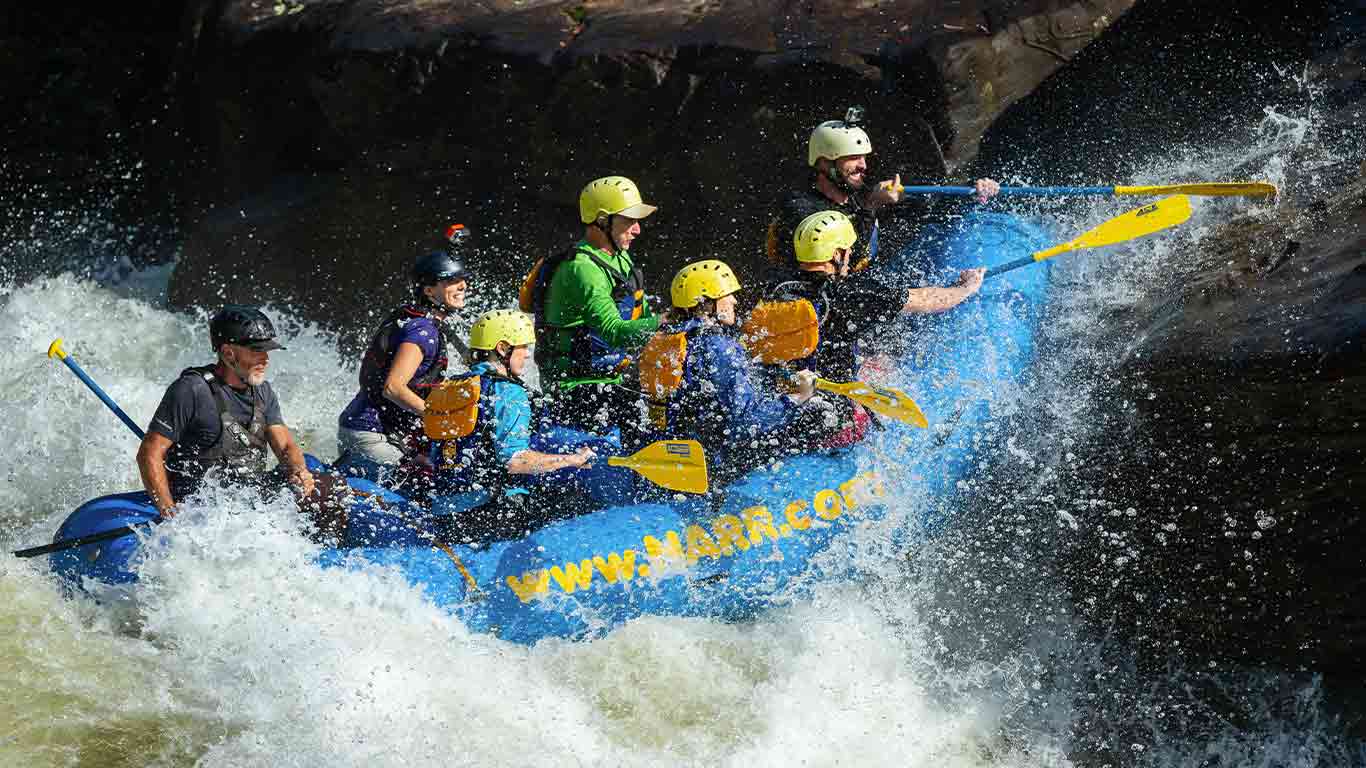Travel Guide
Fall Gauley Season
The New River Gorge In West Virginia
|The Gauley River National Recreation Area
|Fall Gauley Season
Take just one trip, and before you’re even close to half-way through, you’ll understand why every fall, the Gauley River draws people back to its waters. Tucked in a remote, beautiful canyon, it is densely packed with some of the whitewater’s hardest commercially run rapids. Steep and technical, made up of house-sized boulders and near-vertical cascades of water, there are 100 rapids in just 25 miles. Nowhere else can you paddle such a high quality and quantity of rapids in a single day. So special, it has an entire whitewater season with its name on it. Let’s talk about fall Gauley Season! 
In the late 1960s, thanks to a man named John Dragan, commercial rafting in the New River Gorge was born. And by the mid to late 1970s, whitewater rafting on the Gauley was becoming more regular and popular as well. By the early 1980s, word had spread of the quality and intensity of the rapids. Guided rafting trips were in high demand, but the outfitters faced an interesting dilemma, “How much water will be flowing down the Gauley tomorrow?” Summersville Dam was built solely for the purpose of flood control. After the Gauley River meets the New, they form the Kanawha River which flows right through the middle of West Virginia’s capital city, Charleston. Rain and high water events in the New and Gauley watersheds would cause major flooding issues in the capital. The Kanawha River was also an extremely important river for transportation and industry on its course to joining the Ohio River. The US Army Corps of Engineers would manage the flow of water from Summersville Dam with two main considerations in mind: 1) the situation downstream in Charleston, and 2) the amount of flow coming into the lake from the Gauley River headwaters. Lovingly referred to as the “Dam Men” in the whitewater community, the Army Corps had no interest or care in the rafting opportunities that existed downstream, regardless of how “world class” the rapids were.
The problem is that with rafting, knowing the flow of the river is extremely important. Different water levels pose completely different challenges in certain rapids, often affecting the route a guide would take and even the size and/or style of craft that would be best suited for that day. Without knowing what the Army Corps planned to release on a given day made planning a rafting trip down the Gauley extremely difficult. But with the whitewater industry becoming ever more popular on the New River and outfitters wanting to be able to tap into the public demand for the Gauley, rafting companies banned together to take on the US Army Corps of Engineers. And I’m pretty sure no one was more surprised than they were when they won. In 1985, by an act of Congress, whitewater recreation was added to the list of purposes defined for Summersville Dam.
Every fall, the Army Corps would “drain” Summersville Lake. It is the largest lake in West Virginia, totalling nearly 3,000 acres and with 60 miles of shoreline and a maximum depth of 327 ft. In summer months, the lake would be kept at what is known as “summer pool,” with plenty of water for motorized boating and recreation, but in the fall, the level of the lake would be dropped 70 vertical feet. This would then allow the Army Corp to let the lake naturally fill back up the next year catching all the winter and spring rains and helping to mitigate flooding. In the rafting outfitters’ minds, the thought was, “You’re already releasing all that water. Why not just tell us when and how much so we can plan trips around it!” And this was the birth of what we have all come to love and adore, Gauley Season! It is the first ever federally mandated rafting season in the world. Beginning on the first Friday after Labor Day , the whitewater industry is guaranteed six weekends (typically five 4-day releases and one 2-day release) of a scheduled flow of 2,800cfs (cubic feet/second). The rafting industry has never been the same!
Gauley Season attracts whitewater enthusiasts from all over the world. Guests come back year after year, bringing new friends along to experience the thrill that has been so hard to explain. Seasoned river guides come from rivers all over to try and hone their skills and potentially get a chance to guide iconic rapids like Insignificant, Pillow Rock, Lost Paddle, Iron Ring, & Sweet’s Falls. Private boaters, rafters and kayakers and whitewater canoers alike, all make the annual pilgrimage for reunion on the river. Gauley Fest, typically held on the third release weekend, is the largest whitewater festival in the world. Events like the Animal Race, a mass-start, 9-mile down river raft and kayak race, are where legendary stories happen. When it comes to whitewater, in September and October, there is one place everybody wants to be. Good Gauley! It’s Gauley Season!
As many of us do, Bryant responds to many titles. His two favorite roles are husband to his wife Laura and proud Papa to his three girls. Professional titles include guide, instructor, operations manager, race director, photographer, and writer. He has worked in the outdoor adventure industry for 18 years, spending the vast majority of that time leading whitewater rafting and climbing trips here in the New River Gorge region of WV.